#PITTSBURGH EDITOR
Video
youtube
VALERIE DIXON'S CELEBRATION OF LIFE
#18RICCO#VALERIE DIXON#PITTSBURGH PHOTOGRAPHER#PITTSBURGH PHOTOJOURNALIST#PITTSBURGH VIDEOGRAPHER#pittsburgh producer#PITTSBURGH EDITOR#NO DAYS OFF#CELEBRATION OF LIFE#GOD IS GREAT
0 notes
Text

Downtown Pittsburgh, PA. ~1am 2024-02-04.
Taken by me with an iPhone 13 and Microsoft Image Composite Editor.
7 notes
·
View notes
Text
Did the pens just actually fire their GM and assistant GM and president???? Wasn’t this what pens fans were hoping would happen?
#irl hockey#my post editor isn’t showing me my actual text so I can’t tell if I spelled things right sorry#penguins#Pittsburgh penguins#this could be potentially really good for the team right??
3 notes
·
View notes
Text
• United States media archive
#elections#us elections#us politics#democrats#republicans#letter to the editor#america#united states of america#USA#pennsylvania#pittsburgh#electoral politics#election 2024#us presidential election#cold war#us history#corruption#united states#harry truman#voting#voting matters#vote#voter turnout#voter suppression#popular vote#vote blue#vote 2024#GOP#us government#elected officials
1 note
·
View note
Photo
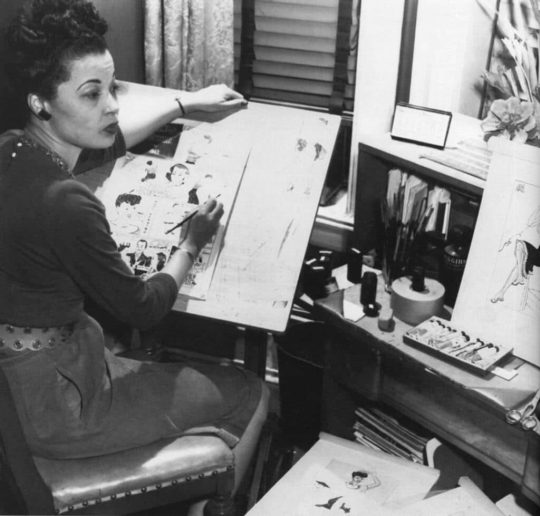

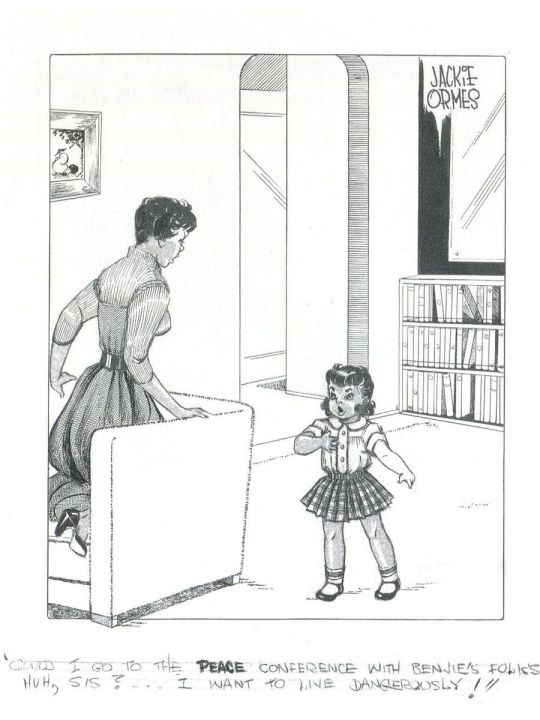
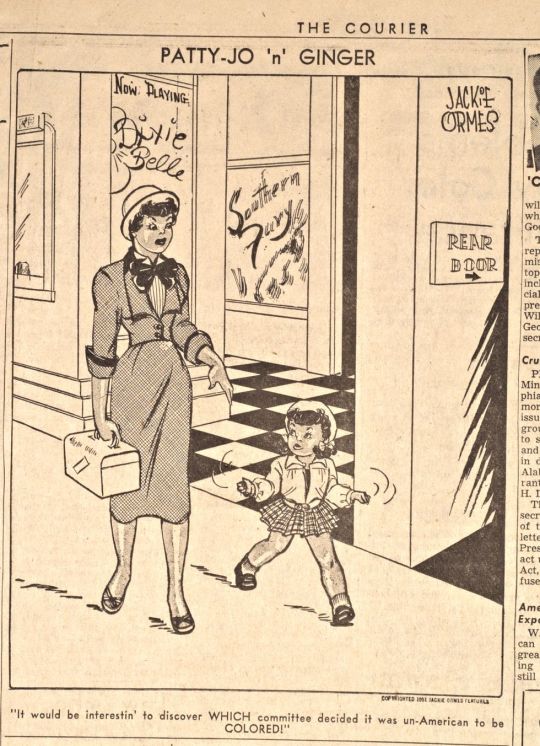

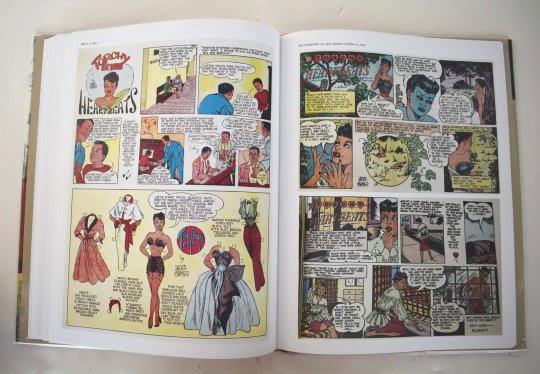
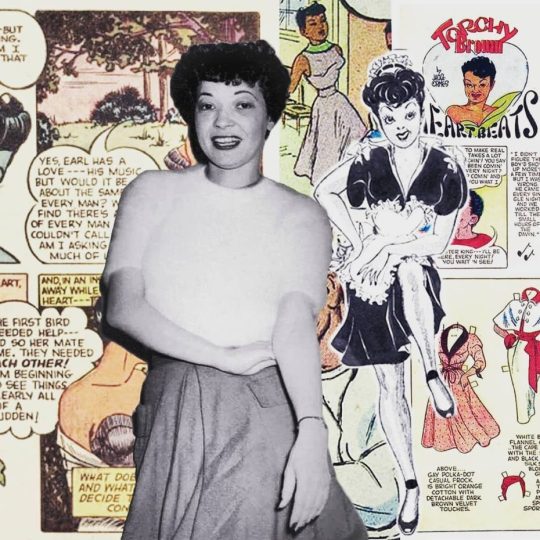
Jackie Ormes, the first Black American woman cartoonist
When the 14-year-old Black American boy Emmett Till was lynched in 1955, one cartoonist responded in a single-panel comic. It showed one Black girl telling another: "I don't want to seem touchy on the subject... but that new little white tea-kettle just whistled at me!"
It may not seem radical today, but penning such a political cartoon was a bold and brave statement for its time — especially for the artist who was behind it. This cartoon was drawn by Jackie Ormes, the first syndicated Black American woman cartoonist to be published in a newspaper. Ormes, who grew up in Pittsburgh, got her first break as cartoonist as a teenager. She started working for the Pittsburgh Courier as a sports reporter, then editor, then cartoonist who penned her first comic, Torchy Brown in Dixie to Harlem, in 1937. It followed a Mississippi teen who becomes a famous singer at the famed Harlem jazz club, The Cotton Club.
In 1942, Ormes moved to Chicago, where she drew her most popular cartoon, Patty-Jo 'n' Ginger, which followed two sisters who made sharp political commentary on Black American life.
In 1947, Ormes created the Patty-Jo doll, the first Black doll that wasn't a mammy doll or a Topsy-Turvy doll. In production for a decade, it was a role model for young black girls. "The doll was a fashionable, beautiful character," says Daniel Schulman, who curated one of the dolls into a recent Chicago exhibition. "It had an extraordinary presence and power — they're collected today and have important place in American doll-making in the U.S."
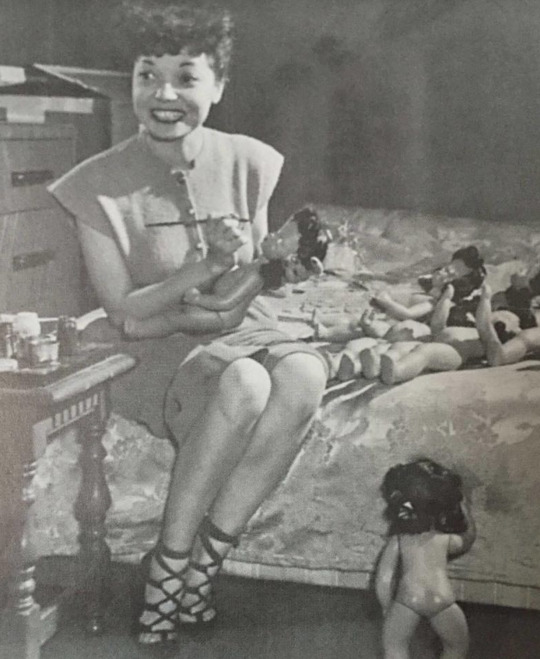

In 1950, Ormes drew her final strip, Torchy in Heartbeats, which followed an independent, stylish black woman on the quest for love — who commented on racism in the South. "Torchy was adventurous, we never saw that with an Black American female figure," says Beauchamp-Byrd. "And remember, this is the 1950s." Ormes was the first to portray black women as intellectual and socially-aware in a time when they were depicted in a derogatory way.
One common mistake that erased Ormes from history is mis-crediting Barbara Brandon-Croft as the first nationally syndicated Black American female cartoonist. "I'm just the first mainstream cartoonist, I'm not the first at all," says Brandon-Croft, who published her cartoons in the Detroit Free Press in the 1990s. "So much of Black history has been ignored, it's a reminder that Black history shouldn't just be celebrated in February."
Source
#jackie ormes#black american history#black history#black cartoonist#black comics#comics#barbara brandon croft#barbara brandon#black artists
3K notes
·
View notes
Note
I seriously can’t believe the phrases “Always in Pittsburgh, only with Sid” and “When I saw you in Latvia for the first time I knew how lucky I was” are not from fan fiction. That shit really happened. Not even at my cringiest teenage girl writer stage could I have made fic Sid say “It’s me AND Geno” because it’s so hacky. But it’s real.
I think maybe they think that it’s totally normal to be like that about your friend and everyone around them is like wtf?
Sid’s like “yeah doesn’t everyone think ‘wow I’m so lucky’ the first time they are their new coworker?’
Geno like “lol wouldn’t you literally flee your home country and move to another one to play with some guy? And then swear undying loyalty to that guy even when the powers that be keep undervaluing your skills and giving you every reason to leave but you just won’t because that’s your guy? Like your favorite guy, you know?
Everyone else just goes “yeah sure totally normal” even though most hockey players wouldn’t do half that shit for the mother of their children. Sorry they are just driving me especially insane today.
anon PLEASE you came for my HEART with this ;___;
you're so right though, like if i were writing a book and i presented the story of Them to my editor they'd be like....ma'am i'm sorry but this is simply not believable. you mean to tell me that your hero here has been in the media since he was literally 7 and his entire reputation is what a genuinely nice guy? NO scandals? and his love interest is a ingenue who smuggled himself out of a foreign country to escape from a repressive threatening shadowy mob boss-esque villain who was on record saying he's lucky that he didn't get conscripted? and then you included all these lines of dialogue in there that they're saying, out loud, to the media about each other? no, sorry, that's all simply too much, the readers won't buy it.
and yet it's real life?? hello?????????
you just know kris has been sitting here these past 17 years watching them like 🤨. maybe that's why he's stayed, he wants to see exactly how ridiculous they can get lmao.
anyway thank u for this i've had a hard time mustering up the right emotional state to think about them to get back to writing my advent fic, and reviewing all of their ON THE RECORD silliness about each other really helped <3 <3 <3
224 notes
·
View notes
Text
@stickypersonaearthquake @imperiuswrecked @thealmightyemprex @themousefromfantasyland @professorlehnsherr-almashy
"This happens with John Byrne a lot. Most fans have just accepted that Byrne has one idea of continuity: his. If he returns to a book (such as The Avengers) that he previously wrote, expect all of the characters to immediately return to the characterizations and stories he was writing when he left, as if all of the ensuing continuity and characterization had simply not happened. Whether this is a good thing or a really terrible thing generally varies on the title, how Byrne wrote it originally, what happened since he wrote it, and whether you're a big fan of John Byrne or not.
When John Byrne took over Star Brand back in The '80s, he proceeded to launch one Take That! after another at the departing figure of ousted Marvel Comics editor-in-chief Jim Shooter. Star Brand was one of the Shooter-initiated The New Universe titles, and was the one that Shooter himself wrote personally. Byrne not only took ad hominem shots at Shooter personally, but had exposition characters hang lampshades on how implausible the events of Shooter's run was, and how stupid the protagonist Ken Connell had been. Early on in Byrne's run, Connell's girlfriend (a major cast member) got killed off; Connell later broke down and tried to get rid of his powers, destroying Pittsburgh (the hometown of both Connell and Shooter) in the process. This was referred to slightly in the Untold Tales of the New Universe story "Tales of the Mulletverse".
In the '80s, John Byrne had grown tired of Magneto's status quo as an Anti-Hero, and wanted him to fall from grace and return to a life of villainy. To achieve this, he and Walt Simonson wrote a story where he did indeed turn back into a villain, and released the New Mutants from his tutelage to boot. Chris Claremont was not at all amused by this, so he responded by writing a story that revealed Magneto was only pretending to be a villain so that he would draw negative attention away from the other mutants of the world.
One reason there's bad blood between John Byrne and Peter David has to do with Lockjaw, The Inhumans' dog. As created by Stan Lee and Jack Kirby, Lockjaw was just a very large, mutated dog with a normal canine intelligence level. Byrne later wrote a Thing issue in which Lockjaw spoke for the first time, begging that baby Luna not be subjected to the Terrigen Mists, since their effects weren't always pretty — implying that he was a full-fledged Inhuman like the others, and the Inhumans had always treated Lockjaw as an animal solely because he looked like one. Thus Peter David revealed that Lockjaw's "speech" had been a prank on Ben Grimm. (As he tells it, this was a request from editorial; David himself didn't have a problem with the scene and wrote his retcon so that it was possible it was Quicksilver that was lying.) This fixed the problems with Byrne's story, but now the Inhumans were Jerkasses for a different reason: pranking Grimm in the middle of an important debate, at Lockjaw's expense. Fans of the Byrne story remain sore about this... and others remain sore about the Byrne story.
When John Byrne took over as writer on the West Coast Avengers, a title previously written by Steve Englehart, he proceeded to undermine four years' worth of characterization. Hawkeye went from confident leader to sidelined jerk. The Vision and Wonder Man relationship, that had evolved into a bond of close fraternity, returned to one of jealous contention. Tigra went through almost the exact same story arc of losing control of herself and succumbing to her feline side that Engelhart had put her through and seemingly resolved. And the Vision and Scarlet Witch marriage... was altered. After the Vision lost his emotions, their children were discovered to be pieces of the devil, after which The Scarlet Witch went insane. For some reason Byrne decided to hit the Reset Button and return the characters to a status they had outgrown in over a decade of stories. Some have accused Byrne of wrecking a title that Englehart had arguably made a success out of resentment over how Englehart had written the Fantastic Four, a title John Byrne had made a hit, although it is just as likely a case of Creative Differences.
On the other hand, Byrne's portrayal of Iron Man in Avengers West Coast (and later in Shellhead's own book) stayed fairly close to how Bob Layton and David Michelinie had portrayed him, although he did remove the weapons-testing aspect from Tony's origin story. He also kept team newcomer U.S. Agent pretty much in line with how Mark Gruenwald wrote him in Captain America.
Byrne & Chris Claremont had a feud of sorts in the 1980's, which started when Claremont wrote X-Men #145 where Arcade basically punks Doom and the X-Men force him to apologize, followed by a later story where Lilandra of the Shi'ar gives Reed Richards a "The Reason You Suck" Speech for saving Galactus' life. Byrne responded by later revealing that the Doom that dealt with Arcade was Actually a Doombot, and had Doom admit that the X-Men weren't even worth his time. Later, in FF #264, Reed was on trial for saving Galactus and was told by basically every cosmic being in the Marvel Universe that yes, he was 100% right in saving his life."
(TV TROPES: ARMED WITH CANON/MARVEL COMICS)
7 notes
·
View notes
Text
Whether you're a student, a journalist, or a business professional, knowing how to do high-quality research and writing using trustworthy data and sources, without giving in to the temptation of AI or ChatGPT, is a skill worth developing.
As I detail in my book Writing That Gets Noticed, locating credible databases and sources and accurately vetting information can be the difference between turning a story around quickly or getting stuck with outdated information.
For example, several years ago the editor of Parents.com asked for a hot-take reaction to country singer Carrie Underwood saying that, because she was 35, she had missed her chance at having another baby. Since I had written about getting pregnant in my forties, I knew that as long as I updated my facts and figures, and included supportive and relevant peer-reviewed research, I could pull off this story. And I did.
The story ran later that day, and it led to other assignments. Here are some tips I’ve learned that you should consider mastering before you turn to automated tools like generative AI to handle your writing work for you.
Find Statistics From Primary Sources
Identify experts, peer-reviewed research study authors, and sources who can speak with authority—and ideally, offer easily understood sound bites or statistics on the topic of your work. Great sources include professors at major universities and media spokespeople at associations and organizations.
For example, writer and author William Dameron pinned his recent essay in HuffPost Personal around a statistic from the American Heart Association on how LGBTQ people experience higher rates of heart disease based on discrimination. Although he first found the link in a secondary source (an article in The New York Times), he made sure that he checked the primary source: the original study that the American Heart Association gleaned the statistic from. He verified the information, as should any writer, because anytime a statistic is cited in a secondary source, errors can be introduced.
Dive Into Databases
Jen Malia, author of The Infinity Rainbow Club series of children’s books (whom I recently interviewed on my podcast), recently wrote a piece about dinosaur-bone hunting for Business Insider, which she covers in her book Violet and the Jurassic Land Exhibit.
After a visit to the Carnegie Museum of Natural History in Pittsburgh, Pennsylvania, Malia, whose books are set in Philadelphia, found multiple resources online and on the museum site that gave her the history of the Bone Wars, information on the exhibits she saw, and the scientific names of the dinosaurs she was inspired by. She also used the Library of Congress’ website, which offers digital collections and links to the Library of Congress Newspaper Collection.
Malia is a fan of searching for additional resources and citable documents with Google Scholar. “If I find that a secondary source mentions a newspaper article, I’m going to go to the original newspaper article, instead of just stopping there and quoting,” she says.
Your local public library is a great source of free information, journals, and databases (even ones that generally require a subscription and include embargoed research). For example, your search should include everything from health databases (Sage Journals, Scopus, PubMed) to databases for academic sources and journalism (American Periodical Series Online, Statista, Academic Search Premier) and databases for news, trends, market research, and polls (the Harris Poll, Pew Research Center, Newsbank, ProPublica).
Even if you find a study or paper that you can’t access in one of those databases, consider reaching out to the study’s lead author or researcher. In many cases, they’re happy to discuss their work and may even share the study with you directly and offer to talk about their research.
Get a Good Filtering System
For journalist Paulette Perhach’s article on ADHD in The New York Times, she used Epic Research to see “dual team studies.” That's when two independent teams address the same topic or question, and ideally come to the same conclusions. She recommends locating research and experts via key associations for your topic. She also likes searching via Google Scholar but advises filtering it for studies and research in recent years to avoid using old data. She suggests keeping your links and research organized. “Always be ready to be peer-reviewed yourself,” Perhach says.
When you are looking for information for a story or project, you might be inclined to start with a regular Google search. But keep in mind that the internet is full of false information, and websites that look trustworthy can sometimes turn out to be businesses or companies with a vested interest in you taking their word as objective fact without additional scrutiny. Regardless of your writing project, unreliable or biased sources are a great way to torpedo your work—and any hope of future work.
For Accuracy, Go to the Government
Author Bobbi Rebell researched her book Launching Financial Grownups using the IRS’ website. “I might say that you can contribute a certain amount to a 401K, but it might be outdated because those numbers are always changing, and it’s important to be accurate,” she says. “AI and ChatGPT can be great for idea generation,” says Rebell, “but you have to be careful. If you are using an article someone was quoted in, you don’t know if they were misquoted or quoted out of context.”
If you use AI and ChatGPT for sourcing, you not only risk introducing errors, you risk introducing plagiarism—there is a reason OpenAI, the company behind ChatGPT, is being sued for downloading information from all those books.
Historically, the Loudest Isn’t the Best
Audrey Clare Farley, who writes historical nonfiction, has used a plethora of sites for historical research, including Women Also Know History, which allows searches by expertise or area of study, and JSTOR, a digital library database that offers a number of free downloads a month. She also uses Chronicling America, a project from the Library of Congress which gathers old newspapers to show how a historical event was reported, and Newspapers.com (which you can access via free trial but requires a subscription after seven days).
When it comes to finding experts, Farley cautions against choosing the loudest voices on social media platforms. “They might not necessarily be the most authoritative. I vet them by checking if they have a history of publication on the topic, and/or educational credentials.”
When vetting an expert, look for these red flags:
You can’t find their work published or cited anywhere.
They were published in an obscure journal.
Their research is funded by a company, not a university, or they are the spokesperson for the company they are doing research for. (This makes them a public relations vehicle and not an appropriate source for journalism.)
And finally, the best endings for virtually any writing, whether it’s an essay, a research paper, an academic report, or a piece of investigative journalism, circle back to the beginning of the piece, and show your reader the transformation or the journey the piece has presented in perspective.
As always, your goal should be strong writing supported by research that makes an impact without cutting corners. Only then can you explore tools that might make the job a little easier, for instance by generating subheads or discovering a concept you might be missing—because then you'll have the experience and skills to see whether it's harming or helping your work.
18 notes
·
View notes
Text
478. 93 things about 1993, part 5

(part 4)
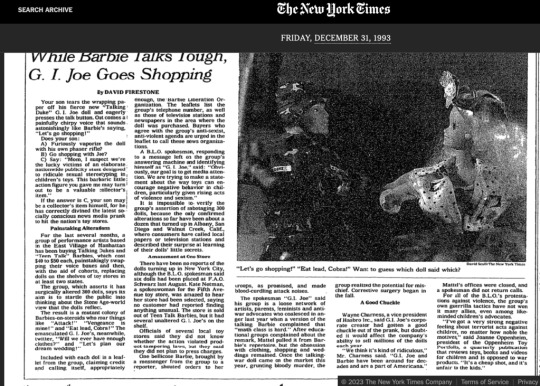
26. G.I. Joe and Barbie's voiceboxes get switched.
A group of performance artists switched the voiceboxes of about 300 G.I. Joe and Teen Talk Barbie. This was later referenced in the Simpsons episode Lisa Vs. Malibu Stacy:

Poor Celeste.

27. Bill's Half Brother

Leon died in 2009 at the age of 70. He and Bill met a few times! 1

28. The first dreidel in space
Spun by Jeff Hoffman.

29. Lawrence comes out in For Better or for Worse (April 10th)


Lawrence, Michael's friend in the strip came out of the closet in the spring of 1993. Of course, people got mad and demanded the strip be pulled from their local papers:
In the next few weeks, Lawrence, who is 17, will also reveal his sexual orientation to his mother and stepfather. Reader beware; the next two sentences give away plot details. His mother will insist Lawrence is mistaken, and his stepfather will throw Lawrence out of the house. He will spend a lonely night in a doughnut shop until Mike locates him and brings him home for a reconciliation with his famiy.
The plot line has already proved too rich for some tastes. Universal Press Syndicate editorial director Lee Salem says about 20 of some 1,400 newspapers subscribing to “For Better or For Worse” have asked for backup material that can be substituted for the Lawrence strips, and eight have canceled the comic outright.
Lynn Johnston, the Canadian cartoonist who writes and draws the 14-year-old strip, says she knew she was entering a sensitive area, but she’s a little surprised by the scope of the negative reaction.
“What I wrote was kind; it was caring,” she says. “It explored both sides of the issue.”
[...]
Thomas Mitchell did. He’s the editor of the Las Vegas Review-Journal, one of the newspapers pulling the Lawrence panels in favor of backup material.
“We had a pretty little heated argument among ourselves,” he says.
Mitchell finally decided parents shouldn’t abruptly find themselves explaining the material to their children over the morning Rice Krispies.
“It’s the comics page, man. Give me a break,” he says. “It’s an interesting topic. Teenage homosexuality: How do you handle it; how do you talk about it?”
Mitchell says he wouldn’t object to a feature story on the subject, possibly illustrated by strips from “For Better or For Worse.”
Bob Hansen of Enfield probably wishes he was getting Mitchell’s newspaper. Hansen is a Courant subscriber who called the paper Monday to complain about the tack Johnston’s strip had taken.
“I’m very upset about it,” he says. “Comics, in the first place, comics are for fun.”
Hansen says he doesn’t object to homosexuals, but he objects to having homsexuality pushed at people who aren’t interested in hearing about it. In particular, he disliked Lawrence’s remark, in Monday’s episode, insisting he isn’t confused about his orientation: “Everybody else is confused.” 2

For the record, I obsessed over For Better or for Worse almost as much as I did Funky Winkerbean. Good to know Lawrence had a good ending as the strip wound to the end in the Summer of 2008.

30. Dana Carvey almost becomes the host of Late Night.
He said no when offered. 3

(eBay user 3d-ology)
31. Addy becomes an American Girl
There was some controversy among the company whether Addy would be "too real" for kids:
Indeed, the story of Addy may be too heavy for the frail shoulders of a doll, and it clearly represents a dramatic shift in the tone of these children's books. While the other dolls face such traumas as wild bears, sailing during a storm or even choosing between loyalty to the crown of England or the patriots of the new Colonies, none can really compare with watching your brother being whipped by a cruel overseer because he "done run off." In "Meet Addy," the first of her series, she escapes from slavery with her mother, after they are forcibly separated from the rest of the family.
Pittsburgh novelist Connie Porter, who was hired to write the Addy books, is aware of the criticism. "Some people don't want to see a character in slavery -- that's ridiculous," she said. "You can run the risk of being so politically correct that you can lose whole periods of history. Children are more ready to talk about these things than some adults are."
Porter, who met twice with the advisory board to discuss story content and the use of dialect, said that she has not trivialized slavery in any way. If anything, she has made it more real to a modern child than it might have been before, she said. "I tried to show how a black child would be treated during the day at the age of 9," she said. "That she had a job like a grown person. Addy works all day worming tobacco plants. She also serves occasionally for the master, who treats her with indifference. At one point they treat her badly. She's a piece of property." 4

32. Krusty gets canceled, but marge doesn’t say anything. (May 13th)
Y'all Ever notice that Marge has no lines in the classic Simpsons episode "Krusty Gets Canceled"? She's there, but no lines. According to the DVD commentaries, Al Jean said that Julie Kavner felt uncomfortable being in an episode with so many celebrity guests, describing it as "tasteless". I guess she changed her mind through the years.
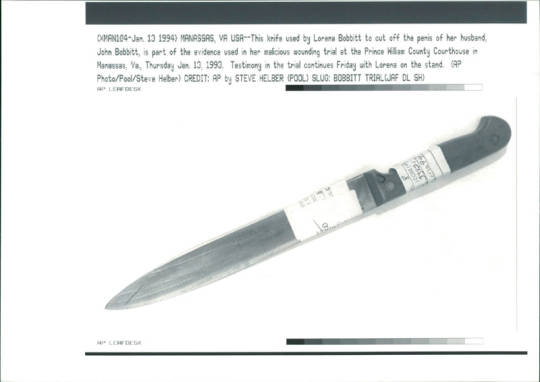
33. Lorena Bobbit copycats
In a four-month period, at least three men besides John Bobbitt had their genitals trashed by angry women. In April, a 29-year-old woman in Milwaukee partially severed her boyfriend's penis after he announced that he wanted to break up, reported the Milwaukee Journal. In Waynesville, N.C., in July, Cynthia Mason Gillett, 28, was charged with setting her husband's genitals on fire while he slept after an argument, reported the Charlotte Observer. In April, Jose Dogelio, 31, was shot in the penis by a woman he was "flashing" on a street in Dasmarinas, Philippines, according to the Manila newspaper, People's Journal. 5
Cynthia was put on probation in January of 1994 because her husband refused to testify against her. She doused his genitals in nail polish and caught them on fire! 6 I could not find Jose's condition.
When I was a kid and I'd see pieces about Lorena and John Bobbit on the news, I pictured Lorena cutting John's penis off with scissors.
Facebook | Etsy | Retail History Blog | Twitter | YouTube Playlist | Random Post | Ko-fi donation | instagram / threads @thelastvcr | tik tok @ saleintothe90s
Barker, Jennifer, and Medianews Group. “Former Paradise Resident Ritzenthaler, Clinton’s Half-Brother, Dies.” Chico Enterprise-Record (blog), January 14, 2009. https://www.chicoer.com/20090114/former-paradise-resident-ritzenthaler-clintons-half-brother-dies/. https://archive.is/YqjO4 .
Hartford Courant. “COMIC TACKLES CONTROVERSIAL ISSUE AS CHARACTER ANNOUNCES HE IS GAY.” March 31, 1993. https://www.courant.com/1993/03/31/comic-tackles-controversial-issue-as-character-announces-he-is-gay/. https://archive.is/dZIGX
Carter, Bill. 1995. The Late Shift: Letterman, Leno, and the Network Battle for the Night. New York: Hyperion. 225-226.
Rosenfeld, Megan. “WHOLESOME BABES IN TOYLAND.” Washington Post, May 24, 1993. https://www.washingtonpost.com/archive/lifestyle/1993/05/24/wholesome-babes-in-toyland/b4ed92ca-1571-4ec9-9290-4dfb4ded0b7b/.
Shepherd, Chuck. “1993: THE YEAR OF THE WEIRD.” Washington Post, December 26, 1993. https://www.washingtonpost.com/archive/opinions/1993/12/26/1993-the-year-of-the-weird/cca1ec6a-5dc9-4be6-9087-e26abe3c657f/.
Tulsa World . “Woman Who Burned Mate Gets Probation.” January 22, 1994. https://1ft.io/proxy?q=https%3A%2F%2Ftulsaworld.com%2Fnews%2Fwoman-who-burned-mate-gets-probation%2Farticle_910a1d92-ff60-57f9-af48-af57d99ad8e2.html
#1993#Lorena bobbit#teen talk barbie#barbie#bill clinton#for better or for worse#dana carvey#american girl dolls#Krusty gets canceled#marge simpson
9 notes
·
View notes
Text

The Exhibitors Herald, June 1926
The first of the deluxe presentations was at the Forrest theatre, Philadelphia, Thursday evening. The audience was composed largely of members of the Advertising Clubs of the World, which was holding an international convention in the Quaker City, and the members of the Poor Richard Club. There were also present a large turnout of society, official and judicial life of Philadelphia.
The other audience, which included Mrs. Coolidge, members of the diplomatic corps and Washington newspapermen, as guests of the National Press club, viewed the picture at a special screening Friday night at Poli’s theatre in Washington.
General W. W. Atterbury; Senator-elect [and notorious political boss] Wm. S. Vare; Senator [and law professor] George W. Pepper; Lieut. Commander Geo. B. Wilson, U. S. Navy [not to be confused with the character from the Great Gatsby] ; Mrs. Barclay Warburton [civil rights supporter and journalist] ; Major Norman MacLeod; E. T. Stottsbury; Paul Thompson; Alexander Van Rensselaer; Mrs. Charlemagne Tower; Dr. H. J. Tily [department story owner, mason] ; Mr. and Mrs. Theodore W. Reath; Frank Smith; Mr. and Mrs. Jos. N. Snellenburg [merchant in clothing trade] ; Mr. and Mrs. Arthur Block; Mr. and Mrs. Jules E. Mastbaum [movie theater and department store magnates] ; George Nitsche [possibly an affiliate of U. Penn]; Josiah H. Penniman [Provost of U. Penn] ; J. Willis Martin [a judge]; H. S. McDevitt; John J. Monaghan.
Judge Buffington, of Pittsburgh; Thos Finletter [could be one of a a number of lawyers with this name]; Mr. and Mrs. A. L. Einstein; Maurice Paillard, French consul; Robt. Von Moschzisker [justice of the Supreme Court of Pennsylvania]; Mayor W. Freeland Kendrick; Geo. H. Elliott, director of public safety; Chas. B. Hall, president of City Council; Dr. Charles Hart; Rev. Wm. H. Fineschriber; Chas Fox, district attorney [could be a coincidence but Charles Fox III and IV are both currently lawyers in Pennsylvania]; John Fisler, president Manufacturers Club [golf afficianado]; Albert M. Greenfield [real estate broker and developer]; Jos. P. Gaffney; Mr. and Mrs. Ellis Gimbel [department store owner]; Daniel Gimbel [brother and co-owner along with Ellis]; J. D. Lit; Richard Gimbel [son of Ellis Gimble]; Benedict Gimbel [brother of Ellis and Daniel]; Colonel Robert Glendinning [banker]; Benjamin Golder [member of the Pennsylvania State House of Representatives], Agnew T. Dice [President of Reading Railroad].
Dr. Leon Elmaleh [founder of the Levantine Jews Society of Philadelphia]; H. Gilbert Cassidy [a judge]; Utley E. Crane [author of Business Law for Business Men]; Cyrus H. K. Curtis [magazine publisher]; Chas. S. Caldwell; G. W. Cole; Hampton L. Carson [lawyer, professor, state Attorney general]; A. Lincoln Acker [Philidelphia port collector]; Max Aron [lawyer]; Eugene C. Bonniwell [a judge]; Chas. L. Brown; Edward Groome; Chas. L. Bartlett; Edward Bok [editor of the Ladies Home Journal]; Mr. and Mrs. Geo. H. Lorimer [editor of the Saturday Evening Post]; Edw. Bacon; Chas. Curtis Harrison [a judge]; Samuel S. Eels, Rev. J. J. O’Hara [future Archbishop of Philadelphia], and Bishop Thos. J. Garland, D. D. [Episcopalian bishop]
There were a bunch of Universal employees in attendance too but that's less interesting to me. Let's see who went to the Washington show
Both showings were under the auspices of Ambassador Henri Beragner of France and Marcel Knecht, French publisher and trade representative.
Dr. Ferdnand Heurteur, leader of the orchestra of the Paris Opera House, came to the United States to conduct the orchestras at these two showings.
Among the distinguished guests at the Washington showing were:
Don Juan Riano, Spanish ambassador; Senor and Senora de Mathieu, Chilan ambassador; Raoul Tilmont, secretary, Belgium embassy; G. H. Thompson, second secretary, British embassy; A. J. Pack, British embassy; Eduardo Racedo and Madame Racedo, first secretary, Argentine embassy; Conrado Traverso, Argentine embassy; Dr. and Senora Velarde, Peruvian ambassador; Dr. and Madame Santiago F. Bedoya, secretary, Peruvian embassy; Senor and Senora Tellez, Mexican ambassador; Senor and Senora Castro, secretary, Mexican embassy; Ambassador de Martino, Italy; Colonel Augusto Villa, miltary attache, Italian embassy; Count and Countess Sommati di Mombello, Italian embassy; Signor Leonardo Vitetti, Italian embassy.
Baron and Baroness Ago Maltzan, German embassy; Mr. and Madame Matsuidaira, Japanese embassy; Mr. and Madame Gurgel de Amaral, Brazilian embassy; Senor and Senora de Sanchez Aballi, Cuban embassy; Senor Don Jose T. Baron, secretary, Cuban embassy; Brigadier General Georges A. L. Dumont, military attache, French embassy; Mr. Jules Henry, first secretary, French embassy; Major and Madame Georges Thenault, French embassy; Captain and Madame Willm, French embassy; Mr. A. Konow Bojsen, secretary, Danish legation; Mr. and Madame Marc Peter, Swiss ambassador; Mr. Andor de Hertelendy, Hungarian embassay; Senor and Senora Ricardo Jaimes Freyre, Bolivian embassy.
Mr. and Mrs. Timothy A. Smiddy, minister, Irish Free State; Mr. and Madame Simoposilis, Minister from Greece; Mr. and Madame Prochnik, Austrian ambassador; Mr. and Madame Charles L. Seya, Latvian embassy; Mahmoud Samy Pasha and Madame Samy Pasha, Egyptian embassy; Mr. Zdenek Fierlinger, Minister from Czechoslovakia; Mr. Simeon Radeff, Bulgarian embassy; Mr. and Madame Jan Ciechanowski, Polish minister; Senor don Manuel Zavala, Nicaragua embassy, and Mr. and Madame Bostrom, Swedish ambassador.
5 notes
·
View notes
Text
DPP Contributor Interview: A. L. Heard

A. L. Heard is one of the founding members of Duck Prints Press and has been a part of our planning team since before our official inception, offering her advice and expertise to the Press since mid-2019, and she’s been an editor on our anthologies Add Magic to Taste, And Seek (Not) to Alter Me, He Bears the Cape of Stars, She Wears the Midnight Crown, and Aim For The Heart. She’s also a prolific author of stories of all lengths and in all genres, and one of the most active authors involved with the Press.
Pre-orders of the revised edition of A. L. Heard’s debut novel Hockey Bois open on December 1st, 2023!
Want to meet A. L. Heard and ask her YOUR questions? YOU CAN! Join us TOMORROW, Thursday, November 30th, at 8 p.m. Eastern time (converter) on our Book Lover’s Discord server for a very special Ask Me Anything session with the author of Hockey Bois!
Author Biography: Ashley, pen name A. L. Heard, fandom name jhoom, is a 35-year-old teacher, writer, and mother of two little boys. She’s been writing fanworks since she discovered fanfiction.net back in her middle school days; the platform has changed and the writing’s improved, but Ashley ultimately still spends her free time writing about characters she adores in worlds she’d like to explore. Her first novel, Hockey Bois, was published in 2021. In between writing projects, she works as a language teacher in the Pittsburgh area, plays hockey, and plays trains with her sons.
Links: Bluesky | Instagram
-
How did you pick the name you create under?
It’s a combination of my [real life] name and family names, making it unique but also still connected to me.
-
When and why did you begin creating?
I started writing fic during middle school and went through phases where I’d write fic and original work and then long periods with no writing. I’m happy to be settled into writing on a regular basis 🙂
-
What’s your favorite part of the creation process?
The brainstorming and playing around with a new story and characters, where everything is still possible and I haven’t had to commit to any particular plot point.
-
Describe your ideal creation space.
An office that’s well lit with an endless supply of tea or coffee or snacks, with no distractions or extra noises except birds. Either that or a brewery or cafe with background noise.
-
What are your favorite snacks and/or drinks to consume while creating?
Tea, coffee, and baked goods (cookies, scones, that sort of thing)
-
What’s one thing (style, genre, etc.) that you think you’ll never do, and why not?
Epic fantasy – they’re awesome stories but I don’t have the creativity/brain for a large scale world and magic system like that.
-
Short Stories A. L. has published with Duck Prints Press:
Brady Jensen vs. Haunted Houses (modern high school Hockey Bois au, m/m, getting together)
Brambles, Pollen, and Other Natural Disasters (modern college Hockey Bois au, explicit, m/m, sex pollen)
In Which James Willoby Enjoys a Ball Far More Than One Should (victorian, explicit, m/m, secret relationship)
Masquerade at Melchor (in the anthology He Bears the Cape of Stars) (science fiction, m/m/m, heist rivals to lovers)
The Musketeer’s Daughter: The Tale of Jacques Toussaint (in the anthology Aim For The Heart: Queer Fanworks Inspired by Alexandre Dumas’s “The Three Musketeers” – coming to our webstore in January, 2024) (historical, f/m, trans musketeer, getting together)
The Offered Ones (fantasy, no ship, found family, children lost in the woods)
The Princess and the Maze (fantasy, no ship, fairy-tale vibe)
Princess Antonia del Montari aka The Accidental Barista (modern, f/f, coffee shop fluff)
Snowbound and Love Sick (modern college Hockey Bois au, explicit, m/m, snowed-in together)
The Tasty Crumpet (in the anthology Add Magic to Taste) (modern with magic, m/m, idiots to lovers)
7 notes
·
View notes
Text
David M. Bowers – Simbología y Precisión

David Bowers, nacido en 1956 en Chambersburg, Pennsylvania y se graduó en la Escuela de Arte de Pittsburgh, en 1979. Empezó a trabajar como artista de personal en diversos estudios en el área de Pittsburgh, PA. Dos años más tarde, David comenzó a enseñar su arte en el Instituto de Arte de Pittsburgh, donde dio clases durante diez años y fue honrado como el orador principal para la clase de 2003. En 1991, David comenzó su carrera trabajando de ilustrador con los editores de libros en Nueva York ciudad, completando más de un centenar de libros en el lapso de diez años. Además, el trabajo de David apareció en la portada de numerosas revistas importantes. También pintó el retrato de J. P. Morgan para la portada de la revista Cigar
5 notes
·
View notes
Text


Over New Year 1976-77, Elvis played the Civic Centre Arena, Pittsburgh, PA, ending a short, five night tour reminiscent of the energy and intensity of the early seventies. The Pittsburgh Post-Gazette published one of the more thoughtful reviews of an Elvis show, written by Mike Kalina who was, interestingly, not a specialist music writer, but a restaurant critic, TV cooking show host and food writer. He obviously came to the show with an open mind, an intention to take the performance on its merits, and report honestly and in-depth, unlike one or two of his counterparts during this period.
“…While Pittsburghers rang in the New Year Friday night in front of their TV sets with Guy Lombardo, 16,409 others scorned 1977 with Elvis Presley at the Civic Arena. After three opening acts and a lengthy intermission, Presley landed on stage 35 minutes before midnight, but you would have thought the clock had struck twelve. He received an ear-deafening ovation punctuated by thousands of blasts from flash bulbs and a patchwork of "We-Love-You-Elvis" signs hoisted aloft… Presley had perhaps the most captive audience since Johnny Cash played Folsom Prison. And rarely did he lose his iron grip on the crowd during his 90 minutes on stage…"
“…Presley was much warmer than on his first visit here in mid-1973. This time he not only interacted with the crowd but he also even gave up the microphone for a minute or so to have a fan wish him happy birthday and happy New Year. He also snapped up dozens of gifts from those who had come to pay homage to him. He gave out 42 scarves and, believe it or not, even took requests. He also was in better voice on this Pittsburgh visit, singing surprisingly well and in a lower register that gave more impact to his phrasing. He even ventured into difficult musical areas, hitting notes that could cause a mild hernia. And after they drew a good crowd reaction, he offered them in a reprise that was tantamount to masochism…”
Mike Kalina was particularly impressed with Charlie Hodge, writing; “To watch his interaction with Presley was worth the price of admission alone.” He went on to make an interesting point about the first rock and roll star to reach a successful middle age. It’s interesting to consider this in the context of the time, rather than now, when many rock and roll icons continue to work well into their seventies and now eighties.
“…He worked hard, but underneath it all one could see that age is taking its toll on the singer. A change in style seems to be the logical career move for him - but Presley seems intent on showing the world that a middle-aged man can rock and roll, too. A famous country artist once said that you can grow old as a country singer but not as a rock singer, Presley is trying to prove him wrong. But he's not succeeding…”
Mike Kalina himself came to a sad end; he took his own life in 1992 (New York Times and AP). It appears he was confronting a health crisis, but was also being investigated by a Grand Jury over allegations of receiving money for favourable restaurant reviews and coverage in his cookbooks and possibly on his television show. The Post-Gazette editor told AP that any such allegations were unproven.
youtube
#elvis history#elvis aaron presley#elvis music#elvis fans#elvis presley#live music#new years eve#elvis in the 70s#entertainment industry#Youtube
27 notes
·
View notes
Text
24 Days of La Fayette: December 23rd – Presley Neville
Presley Neville (1756-1818) came from a wealthy and prominent Virginian family that had senior members serving with George Washington during the French and Indian War.
Presley was born on September 6, 1756 in Winchester, Virginia. He was the only surviving son and oldest child of General John Neville and Winifred (Oldham) Neville. The two had married on August 24, 1754. The family moved from Frederick County in Virginia to the outskirts of Pittsburgh in about 1775. Despite this, the men fought in the Virginia line of the Continental Army and not in the Pennsylvania line.
Neville was one of La Fayette’s earliest aide-de-camps when he joined the Marquis’ staff in December of 1777. The early months of his service were unremarkably but we have a number of letters that he copied for La Fayette. But things soon became rather more exciting.
In October of 1778, La Fayette desired promotions for his aide-de-camps, but out of the four men he recommended, only his two American aide-de-camps, Edmund Brice (day 1) and Neville received promotions. George Washington wrote in a letter to Henry Laurens on October 30, 1778:

“To George Washington from Henry Laurens, 30 October 1778,” Founders Online, National Archives, [Original source: The Papers of George Washington, Revolutionary War Series, vol. 17, 15 September–31 October 1778, ed. Philander D. Chase. Charlottesville: University of Virginia Press, 2008, pp. 647–649.] (06/07/2023)
When La Fayette planned to return to France for the first time since joining the army, he requested that Neville would be permitted to accompany him. He wrote to Washington on January 1, 1779:
This letter will be delivered to your excellency by Mr. Nevill may aid de Camp whom I beg you to favor with a leave of absence for joining me in France. Besides the affection I have for that gentleman, I also think this voyage may forward the public good as he will be intrusted with those dispatches Congress is going to send. (…) I also intreat your friendship not to forget writing to me, and if you grant the leave I solicit for Mr. Nevill his arrival with letters from you will make me extremely happy.
Gottschalk, Bill, editors, The Letters of Lafayette to Washington,1777-1779, The American Philosophical Society, Philadelphia, 1976, p. 73.
Washington granted La Fayette’s request and he then told friends like Hamilton that Neville was joining him in France. He even wrote the Comte de Vergennes on May 23, that he was expecting three American and one French officer. The only problem; Neville never did leave America, and La Fayette was not aware of this fact.
Washington wrote to La Fayette on March 8-10, 1779:
(…) I have not had the Letters returned to me by Majr Neville, who I am told (but this is no excuse) is indisposed at Fish-kill (…)
“From George Washington to Major General Lafayette, 8–10 March 1779,” Founders Online, National Archives, [Original source: The Papers of George Washington, Revolutionary War Series, vol. 19, 15 January–7 April 1779, ed. Philander D. Chase and William M. Ferraro. Charlottesville: University of Virginia Press, 2009, pp. 401–405.] (06/07/2023)
The postscript of the same letter reads:
I have this moment receivd the letters which were in the hands of Majr Neville; accompanied by yr favors of the 7th & 11th of Jany. the Majr himself is not yet arrived at head Qrs; being, as I am told, very sick (…)
This is quite the peculiar statement since La Fayette himself was severely indisposed in Fishkill prior to leaving America – and Neville’s luck was far from improving over the coming months.
La Fayette wrote on June 12, 1779 to Washington:
I don’t know what is Become of Cle. Nevill and the Cher. de La Colombe. I beg you would make some inquiries for them, and do any thing in your power for theyr speedy exchange in case they have been taken.
Idzerda Stanley J. et al., editors, Lafayette in the Age of the American Revolution: Selected Letters and Papers, 1776–1790, Volume 2, April 10, 1778–March 20, 1780, Cornell University Press, 1978, p. 278.
Washington replied on September 30, 1779:
Colo. Neville called upon me about a month since and was to have dined with us the next day but did not come, since which I have not seen him nor do I know at this time where he is. He had then but just returned from his own home & it was the first time I had seen him since he parted with you at Boston. It is probable he may be with the Virginia Troops which lye at the mouth of Smith’s Cloves abt. 30 mile from hence.
Idzerda Stanley J. et al., editors, Lafayette in the Age of the American Revolution: Selected Letters and Papers, 1776–1790, Volume 2, April 10, 1778–March 20, 1780, Cornell University Press, 1978, p. 315.
Neville served for a time as lieutenant-colonel in the 8th Virginia Regiment. He became a prisoner of War on May 12, 1780 after the Fall of Charlestown together with John Laurens. He was quickly paroled and finally exchanged in May of 1781. La Fayette instructed the Chevalier de La Luzerne on June 20, 1780:
May I presume to ask you to convey a million compliments to Monsieur de Marbois and to find out if the son of Colonel Neville, called Lieutenant Colonel Presley Neville, my former aide-de-camp, is among the prisoners?
Idzerda Stanley J. et al., editors, Lafayette in the Age of the American Revolution: Selected Letters and Papers, 1776–1790, Volume 3, April 27, 1780–March 29, 1781, Cornell University Press, 1980, p. 57.
La Fayette also wrote to Nathanael Greene on November 10, 1780:
I have a Request to Make, My dear Sir, Which is extremely interesting to me. Young Nevile, My aid de camp, a Captain By Commission, and a Lieutenant Colonel By Brevet was taken as a Volonteer at Charlestown. The General has told me that you was invested with full Powers to treat for the Southern Prisoners. Nothing, May Give me a Greater pleasure than to have My poor Nevile out of the Scrape which his zeal and Bravery have thrown him into. I was thinking of writing to him, But upon Recollection Believe it More advantageous to his exchange that No Notice Be taken of him till he has obtain’d his freedom.
Idzerda Stanley J. et al., editors, Lafayette in the Age of the American Revolution: Selected Letters and Papers, 1776–1790, Volume 3, April 27, 1780–March 29, 1781, Cornell University Press, 1980, p. 224.
Neville was not permitted to leave the city of Philadelphia as part of his parole. But when La Fayette was himself in Philadelphia, the two men met and the Marquis was more determined than ever to get his “favourite” back. He consulted Washington on this matter on December 9, 1780:
I have found here Lt. Clel. Nevill my old aid de camp. He came with Gal. Woodfort to Newyork. It is said that Gal. Lincoln’s aids have been exchang’d and that it is generally the case with aids de camp to Gal. officers actually in our service. I warmly desire to have him. I am told Cornwallis has no powers to treat those matters. Can you, my dear general, think of some method to get him out which it is proper for me to take? I am more than ever puzzled, my dear general, to know what to do.
Idzerda Stanley J. et al., editors, Lafayette in the Age of the American Revolution: Selected Letters and Papers, 1776–1790, Volume 3, April 27, 1780–March 29, 1781, Cornell University Press, 1980, p. 254-255.
Washington replied to La Fayette on December 14, 1780:
It would add to my pleasure if I could encourage your hope of Colo. Nevilles exchange. I refused to interest myself in the exchange of my own aid. Genl. Lincoln’s were exchanged with himself, and upon that occasion (for I know of no other) Congress passed a resolve prohibiting exchanges out of the order of captivity.
Idzerda Stanley J. et al., editors, Lafayette in the Age of the American Revolution: Selected Letters and Papers, 1776–1790, Volume 3, April 27, 1780–March 29, 1781, Cornell University Press, 1980, p. 259.
After his exchange in May of 1781, Nevill returned to serve as La Fayette’s aide-de-camp during July of 1781 – until he was captured again. La Fayette wrote on August 12, 1781 to Nathanael Greene:
I May add that Clel. Nevill and Mr. Langhorne Being prisoners, I Have No aid de Camp But McHenry and Washington, But I am willing to give up My interest to your wishes, and McHenry's Remaining Some time with me is owing to an other Circumstance.
Idzerda Stanley J. et al., editors, Lafayette in the Age of the American Revolution: Selected Letters and Papers, 1776–1790, Volume 4, April 1, 1781–December 23, 1781, Cornell University Press, 1981, p. 319.
The details of Neville’s second capture are unknown. He was released sometimes in 1782 and as far as I can tell never returned to serve under La Fayette. Instead, he married Nancy Morgan, the daughter of General Daniel Morgan in 1782 and they moved with their family to a house known as Woodville about six miles west of Pittsburgh. Their home was situated on the banks of the Chartiers Creek and Neville’s father lived on the opposite site of the creek. Around 1794 he served as inspector for the Allegheny County militia. His county also saw a great opposition to the Act repealing, after the last day of June next, the duties heretofore laid upon Distilled Spirits imported from abroad, and laying others in their stead; and also upon Spirits distilled within the United States, and for appropriating the same, better known as the act that raised taxes on alcohol distilled within the United States. Both Presley Neville as well as his father General John Neville found themselves the victims of attacks and threats during the Whisky Rebellion. It did not help much that Neville was the agent for procuring whiskey for the army.
On December 10, 1819, shortly after his father’s death, Neville’s son Morgan Neville addressed himself to Thomas Jefferson with a particular interest:
The Motive for my present communication, must plead my Excuse for intruding upon you, & the history of your Life, is a pledge to every American, that the humblest request will be attended to.
I am the Representative of the late General D. Morgan of Virginia, to whom Congress presented a gold Medal for the battle of the Cowpens. This descended to me as the eldest male Grandchild of this officer. Unfortunately, a Bank, in which the Medal was deposited, was last year robbed, & this with many other valuable articles belonging to me, was taken. I have lost all hopes of recovering it, as I have reason to believe that one of the Robbers threw it into the St Lawrence: I leave it to you, sir, to judge of my mortification since this event.
I have determined to petition Congress, through my friend, the honorable Henry Baldwin, to pass a Resolution authorizing me to have one struck at my Expense; as my situation however, at present would not permit me to take advantage of such a resolution, without having the original Die, I have written on the subject to Mr Gallatin, & to the Marquis de la Fayette, whose Aid de Camp, my father the late General Presley Neville was, in “77. Since writing to these gentlemen it has occurred to me that, as the Medals voted by Congress were executed under your direction, you might be able to assist me with your advice; if I be not mistaken you employed on that occasion three artists; Duvivier, Dupré, & Cateau. My Grandfather’s was executed by Dupré. Any information which you may have the goodness to give me as to where these dies were deposited; whose property you consider them; the possibility of my procuring the one I want, & what course I ought to pursue, will be most gratefully acknowledged by me. By gratifying me with a reply to this communication, you will lay me under a most serious obligation.
“Morgan Neville to Thomas Jefferson, 10 December 1819,” Founders Online, National Archives, [Original source: The Papers of Thomas Jefferson, Retirement Series, vol. 15, 1 September 1819 to 31 May 1820, ed. J. Jefferson Looney. Princeton: Princeton University Press, 2018, pp. 276–278.] (06/07/2023)
#24 days of la fayette#la fayette's aide de camps#marquis de lafayette#la fayette#french history#american history#american revolution#history#letter#george washington#john laurens#nathanael greene#thomas jefferson#founders online#danial morgan#nancy morgan#presley neville#morgan neville#fall of charlestown#1777#1778#1779#1780#1781#1782#1794#1819#whisky rebellion
8 notes
·
View notes
Text
TOO MANY FUCKING ACRONYMS
THERE ARE TOO MANY ACRONYMS IN THE WORLD
STOP IT. ITS GONE TOO FAR
Sub-Saharan Africa?
Safe Schools Alliance, a British advocacy group?
SSA Global Technologies, American software company acquired by Infor Global Solutions?
Shan State Army, a former insurgent group in Burma?
Slovak Society of Actuaries (Slovak: Slovenská spoločnosť aktuárov), professional association in Slovakia?
Soaring Society of America, American sporting society founded in 1932?
Society of Scottish Artists, artists society founded in 1891?
Swedish Society of Radio Amateurs, an amateur radio organization?
Singapore Scout Association, youth movement founded 1910?
Seismological Society of America, international scientific society founded 1906?
Scottish Socialist Alliance, a coalition of left-wing bodies, fore-runner to the Scottish Socialist Party?
Shipconstructors' and Shipwrights' Association, a former British trade union?
Sainsbury's Staff Association, of Sainsbury's, UK?
Sudan Studies Association, US professional association?
Society for the Study of Addiction, UK learned society with charitable status?
Steamship Authority, a Massachusetts ferry service and regulatory body?
School of Saint Anthony, Quezon City, Philippines?
Secular Student Alliance, US?
Shady Side Academy, Pittsburgh, Pennsylvania, US?
Social Security Administration of the US government?
Social Security Agency (Northern Ireland)?
State Security Agency (South Africa), the South African intelligence service?
Selective Service Act of 1917, an American piece of legislation signed by President Woodrow Wilson during WWI that established nationwide conscription?
Software Security Assurance?
Serial Storage Architecture?
Singular Spectrum Analysis?
Stationary Subspace Analysis?
Static single-assignment form, a property of intermediate representations used in compilers?
Stochastic Simulation Algorithm?
Strong subadditivity of quantum entropy?
SubStation Alpha and .ssa file format, a video subtitle editor?
Super systolic array?
Start of Selected Area, a control character in the C1 control code set?
Solid State Array, in flash data storage using solid-state drives?
Semantic structure analysis?
Single-strand annealing in homologous recombination?
Specific surface area, a property of solids?
Side-side-angle in geometry for solving triangles?
Senile systemic amyloidosis?
Sessile serrated adenoma, a type of pre-malignant intestinal polyp?
Special somatic afferent?
Anti-SSA/Ro autoantibodies?
Sulfosalicylic acid?
SSA, Grand Cross of the Order of the Star of South Africa?
Deputado Luís Eduardo Magalhães International Airport, IATA Airport code?
Same sex attraction?
Safe Sex Always?
Sarva Shiksha Abhiyan, the Government of India's Education for All programme?
Self-sampling assumption?
Shared services agreement?
Slippery slope argument, a rhetorical device (and often a fallacy)?
ESA Space Situational Awareness Programme?
Special services area or business improvement district?
Special Service Agreement between the UN and a contractor?
Supervisory Special Agent?
Serious Sam Advance, a 2004 video game?
WHICH OF THESE ARE YOU TALKING ABOUT????????
10 notes
·
View notes
Text
Today in Christian History
Today is Tuesday, January 2nd, 2024. It is the 2nd day of the year in the Gregorian calendar; Because it is a leap year, 364 days remain until the end of the year.
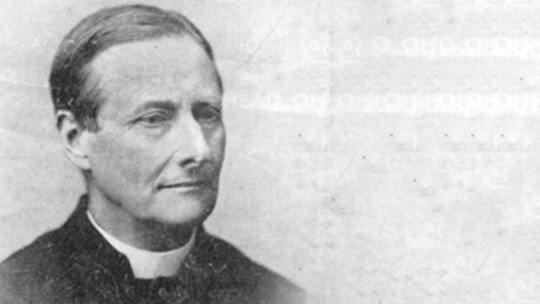
303: According to tradition, Roman Emperor Diocletian orders a slaughter of Christians at an English town which, because of the event, becomes known as Lichfield, “field of corpses.”
1492: The Moors surrender Granada to Ferdinand II of Aragon and Isabella I of Castile.
1542: Calvin’s Ecclesiastical Ordinances are ratified as church law in Geneva.
1792: Death in Canterbury, Kent, England, of Edward Perronet who had written the hymn “All Hail the Power of Jesus’ Name.”
1849: Seventeen-year old John Norton Loughborough gives his first public talk. Filled with certainty Christ will soon return, he has rented a church in upper New York to lecture on the subject. Eventually he will become an influential leader of the Seventh-day Adventists.
1878: Death near Birmingham, England, of Edward Caswall, author of the hymn “When Morning Gilds the Skies.”
1883: Death in Philadelphia of Charles Porterfield Krauth. A Lutheran pastor, editor, and educator, he had spent his life promoting conservative Lutheran theology and a literal reading of the Augsburg Confession.
1905: Sergius Georgievich Golubyatnikov, known as “Seraphim,” is consecrated Bishop of Mozhaisk. While serving in a later post at Ekaterinburg and Irbit he will condemn the Bolsheviks’ February revolution, for which he will be sent to the Novospassky monastery in Moscow, becoming its first prisoner when it is turned into a prison. There he will be shot.
1921: KDKA, a Pittsburgh radio station, broadcasts a service from Calvary Episcopal Church to test its ability to make remote broadcasts; this is the first religious broadcast ever made.
1924: Death of Sabine Baring-Gould (pictured above) at Exeter, England. An Anglican clergyman, he will be remembered as the author of two popular hymns: “Onward Christian Soldiers” and “Now the Day Is Over.”
4 notes
·
View notes